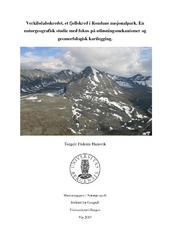Verkilsdalsskredet, et fjellskred i Rondane nasjonalpark. En naturgeografisk studie med fokus på utløsningsmekanismer og geomorfologisk kartlegging.
Master thesis
Permanent lenke
https://hdl.handle.net/1956/7002Utgivelsesdato
2013-05-15Metadata
Vis full innførselSamlinger
- Department of Geography [634]
Sammendrag
The main objectives of this thesis are to clarify causes and triggers and the geomorphology of a ca. 12 kyr landslide in Verkilsdalen, Rondane National Park, Norway. A high resolution (33*33 cm) Digital Elevation Model (DEM) is constructed in Agisoft Photoscan Professional. The geomorphology is mapped by analyzing the DEM in a Geographical information system (GIS). Strike and dip measurements are performed on the bedrock to highlight weak schist zones. In addition 10Be exposure dating, temperature logging and weathering measurements help clarify the causes of the landslide and geomorphological processes of the feature. The theoretical framework of this thesis includes literature within physical geography, including theories around paraglacial rock-slope stability, permafrost and periglacial processes and structural geology. On basis of spatial analysis the study object is initially classified as a rock-slide, associated with the dip of schist cleavage planes. Local temperature monitoring, flow structures, ice and access of water in the deposit show the presence of an active rock glacier above ca. 1420 masl. Negative temperature anomaly in the deposit could extend the processes associated with rock glaciers below the regional permafrost. Topography in addition to lithology are the most important factors preconditioning the landslide event. Although one can't pinpoint only one trigger to the event, several possibilities are defined as likely to be preparatory. These factors are water and high cleft water pressure, seismicity, glacial debuttressing, glacial erosion and freeze-thaw processes. The climatic context of the age suggested from the exposure datings indicate that chemical weathering and thawing permafrost could not have been a trigger or preparatory factor for the landslide event.
